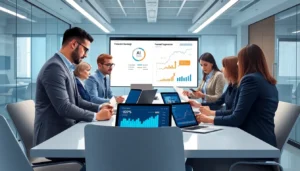In a world where procurement’s often seen as the dull cousin of supply chain management, emerging technologies are shaking things up like a double espresso on a Monday morning. Imagine robots handling tedious tasks while AI analyzes data faster than you can say “cost savings.” It’s not just a dream; it’s the future of procurement, and it’s here to make life easier and more efficient.
As companies scramble to stay ahead of the curve, embracing these innovations isn’t just smart; it’s essential. From blockchain ensuring transparency to machine learning predicting trends, the procurement landscape is transforming faster than you can refresh your email. Buckle up; it’s time to explore how these technologies are revolutionizing the way businesses buy, negotiate, and manage their resources. Who knew procurement could be this exciting?
Table of Contents
ToggleOverview of Emerging Technologies in Procurement
Emerging technologies significantly reshape procurement practices. Robotic process automation (RPA) streamlines repetitive tasks, reducing time and minimizing human error in procurement processes. Artificial intelligence (AI) empowers data analysis, enabling better decision-making based on historical spending patterns and supplier performance metrics.
Blockchain technology enhances transparency and traceability, allowing organizations to verify the authenticity of products and monitor their movement throughout the supply chain. Machine learning algorithms analyze vast datasets, identifying trends and making predictions that help procurement professionals optimize their strategies.
Cloud-based platforms facilitate collaboration between procurement teams and suppliers, providing access to real-time data and improving communication. These platforms make it easier to manage contracts, track inventory, and automate purchase orders, significantly boosting efficiency.
Internet of Things (IoT) devices connect various procurement elements, allowing real-time monitoring of inventory levels and supplier shipments. This connectivity leads to more accurate forecasts and timely responses to changes in demand.
Enhanced analytics tools provide procurement specialists with insights into spend analysis, supplier risk assessments, and market trends. Companies leveraging these analytics can refine sourcing strategies and negotiate better terms with suppliers.
As these technologies continue evolving, organizations adopting them can achieve a competitive edge. By integrating these innovations into their procurement processes, they foster a culture of continuous improvement and adaptability.
Key Technologies Transforming Procurement

Emerging technologies significantly reshape procurement practices, enhancing efficiency and decision-making.
Artificial Intelligence and Machine Learning
Artificial intelligence (AI) analyzes historical data for better insights into spending patterns and supplier performance. Machine learning models identify trends by processing vast datasets. Predictive analytics informs stakeholders about potential disruptions and opportunities. Evidence shows that companies integrating AI in procurement can achieve up to 30% cost savings. Immediate access to insights empowers procurement teams to make quicker, data-driven decisions.
Blockchain Technology
Blockchain technology enhances transparency throughout the supply chain. It allows for secure tracking of transactions, improving traceability from production to delivery. Each transaction is recorded in a tamper-proof ledger, which fosters trust between all parties involved. This technology can significantly reduce fraud and errors, ensuring payments and contracts are executed smoothly. Organizations utilizing blockchain in procurement experience enhanced accountability in their supplier relationships.
Internet of Things (IoT)
The Internet of Things (IoT) enables real-time monitoring of inventory and shipments. Connected devices provide accurate data on stock levels and shipment statuses, facilitating better demand forecasting. Automation of inventory management reduces human error and increases responsiveness to supply chain changes. Organizations leveraging IoT technology improve operational efficiency significantly, as they can reduce excess inventory and optimize usage of resources. With enhanced visibility, procurement professionals can react promptly to shifts in market conditions.
Benefits of Implementing Emerging Technologies
Emerging technologies provide significant advantages in procurement, particularly in efficiency and decision-making.
Enhanced Efficiency and Automation
Robotic process automation (RPA) greatly reduces the time spent on repetitive tasks. It minimizes human error, leading to streamlined workflows. Tasks such as data entry, invoice processing, and order tracking benefit immensely from automation. Companies integrating these solutions often report shorter cycle times and improved productivity. Additionally, automation enhances the accuracy of procurement processes. By freeing up human resources, teams can focus on strategic activities rather than mundane tasks.
Improved Data Analytics and Decision-Making
Artificial intelligence (AI) transforms data analysis, enabling procurement teams to derive actionable insights from historical spending patterns. Organizations leveraging AI technology experience up to 30% cost savings. Machine learning models provide the ability to identify trends, offering data-driven support for decision-making. Predictive analytics informs stakeholders about potential disruptions, helping them adjust strategies proactively. Enhanced analytics tools allow for refined sourcing strategies and better management of supplier risks. Companies that embrace these advanced analytics capabilities position themselves to make informed decisions that drive long-term success.
Challenges in Adopting New Technologies
Emerging technologies present various challenges in procurement. Organizations often face significant hurdles when attempting to integrate these innovations into current workflows.
Integration with Existing Systems
Integrating new technologies with existing systems poses a unique challenge. Compatibility issues may arise, causing delays and increasing costs. Organizations often struggle to align new solutions with legacy systems, which can lead to inefficiencies. Ensuring data flows seamlessly between platforms requires careful planning and execution. Comprehensive assessments of existing infrastructure help identify potential obstacles before implementation begins. Choosing flexible solutions that accommodate future growth can ease integration difficulties. Successful integration ultimately enhances overall procurement efficiency and effectiveness.
Change Management and Training
Change management proves essential when adopting new technologies. Employees might resist alterations to established processes, creating barriers to effective implementation. Engaging team members early in the transition fosters acceptance and reduces anxiety. Providing training sessions equips staff with necessary skills to navigate new systems confidently. Clear communication about the benefits of these technologies encourages buy-in from stakeholders. Continuous support throughout the adaptation process reinforces learning and promotes successful technology integration. Organizations that prioritize training and change management cultivate a more competent and adaptable workforce.
Future Trends in Procurement Technologies
Emerging technologies continue to reshape procurement strategies across industries. Companies increasingly prioritize automation to enhance productivity. Robotic process automation significantly reduces time spent on repetitive tasks, including data entry and invoice processing. AI integration leads to a potential 30% cost savings by improving data analysis and decision-making.
Predictive analytics provides valuable insights into market trends, enabling organizations to adjust strategies before disruptions occur. Machine learning algorithms further identify trends by analyzing vast datasets, ensuring informed procurement decisions. Blockchain technology enhances both transparency and traceability in the supply chain, fostering trust between organizations and suppliers.
Cloud platforms promote real-time collaboration and access to critical data, making contract management more efficient. IoT devices facilitate immediate inventory monitoring, enabling accurate demand forecasting. Organizations benefit from increased responsiveness as they manage fluctuations in the supply chain.
In addition to these advancements, analytics tools enhance spend analysis and supplier risk assessment, refining sourcing strategies for companies. Challenges still exist; integration with legacy systems remains a primary concern, possibly causing delays. Companies must assess their current infrastructure thoroughly to overcome these obstacles. Choosing adaptable solutions can accommodate future growth.
Employee engagement is vital during transitions. Providing comprehensive training helps mitigate resistance to changes in established processes. Clear communication about technology benefits fosters stakeholder buy-in. Continuous support solidifies learning and cultivates an adaptable workforce.
Emerging technologies are revolutionizing procurement, driving efficiency and innovation. As organizations integrate AI, blockchain, and automation, they position themselves for success in a competitive landscape. The shift towards data-driven decision-making and real-time collaboration is reshaping procurement into a dynamic field.
While challenges like system integration and employee resistance exist, proactive change management can ease the transition. Companies that embrace these technologies will not only enhance operational efficiency but also foster a culture of adaptability. The future of procurement is bright for those willing to invest in these advancements, ensuring long-term growth and resilience in an ever-evolving market.










